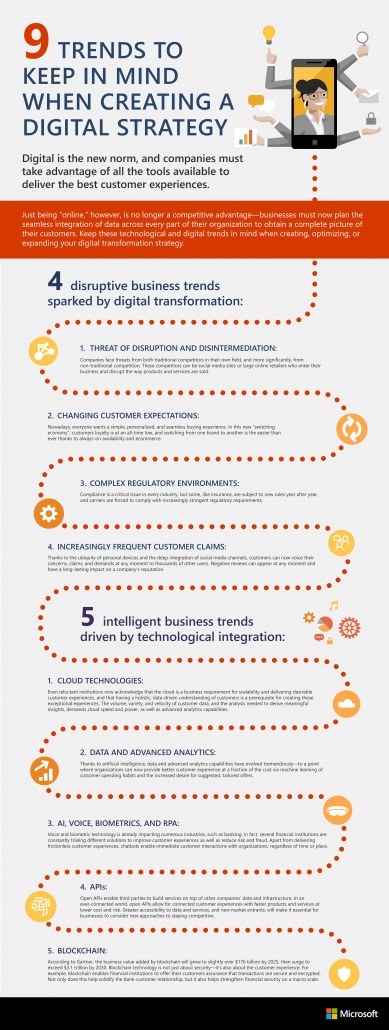9 Trends to Keep in Mind When Creating A Digital Strategy
Digital is the new norm, and companies must take advantage of all the tools available to deliver the best customer experiences, become more agile and efficient and stay competitive.
Just being “online,” however, is no longer a competitive advantage—businesses must now plan the seamless integration of data across every part of their organization to obtain a complete picture of their customers. Keep these technological and digital trends in mind when creating, optimizing, or expanding your digital transformation strategy.
Centralizing your data across departments such as finance, project management, sales and customer service, operations and others is essential to have the complete picture of your business and make the right inform decision.
4 Disruptive Business Trends Sparked by Digital Transformation
Disruption was the name of the game in 2020 and businesses in Malaysia despite cutting budgets have rarely valued information technology more.
From remote working and collaboration to enable employees to work from anywhere at anytime technologies like cloud computing and remote collaboration tools have played a significant role in mitigating the damage caused by a global pandemic.
Now, businesses in Malaysia are much better equipped to work from home, office, or anywhere else, but that is only the beginning as the new normal is going to stay.
So as we are rolling through 2021, here are 4 disruptive business trends sparked by digital transformation:
1. The threat of Disruption and Disintermediation
Companies face threats from both traditional competitors in their own field, and more significantly, from the non-traditional competition. These competitors can be social media sites or large online retailers who enter their business and disrupt the way products and services are sold.
Given the accelerating pace of change, companies need to transform themselves for a world where they are no longer protected by entry barriers, competition comes from all directions, and digitalization will become the major agent of change.
We believe that companies will need to embrace innovation and encourage new ideas. They also need to respond with agility and take advantage of regulatory changes.
2. Changing Customer Expectations
Nowadays, everyone wants a simple, personalized, and seamless buying experience. In this new “switching economy”, customer loyalty is at an all-time low, and switching from one brand to another is easier than ever thanks to always-on availability and eCommerce.
According to SuperOffice, customer experience has fast become a top priority for businesses and 2021 will be no different and it can be challenging providing a consistent experience across all channels. A gold standard here is IKEA.
If you visit any IKEA store around the world, you will get the same experience. IKEA invests heavily in customer experience. Last year alone, they’ve opened more stores, invested in its home delivery network, and launched a brand new app – all to the benefit of their customer.
3. Complex Regulatory Environments
Compliance is a critical issue in every industry, but some, like insurance, are subject to new rules year after year, and carriers are forced to comply with increasingly stringent regulatory requirements.
Meeting compliance obligations in a dynamic regulatory environment is complex. If you ask security, compliance, and IT professionals what keeps them up at night, the most common response is simple: data. It’s just one word, but it carries so much weight for organizations these days.
The amount of data being created, shared, and stored today has grown exponentially. Adding to that, the requirements to keep it all secure, private, and compliant are more complex than ever before.
From managing hybrid environments to keeping up with regulations, it’s vitally important you trust the partner that handles your data.
4. Increasingly Frequent Customer Claims
Thanks to the ubiquity of personal devices and the deep integration of social media channels, customers can now voice their concerns, claims, and demands at any moment to thousands of other users. Negative reviews can appear at any moment and have a long-lasting impact on a company’s reputation.
5 intelligent business trends driven by technological integration:
After the post-Covid world, we should anticipate that the traditional way of doing business will no longer exist and many business processes and customer interaction will be digitalized.
Many things are going to change, business models will need to be adapted and a lot of those changes will come the way how businesses will be using technologies to become more productive, efficient, save costs and do more with less.
Therefore let us share with you our five top intelligent business trends driven by technological integration:
1. Cloud Technologies
Even reluctant institutions now acknowledge that the cloud is a business requirement for scalability and delivering desirable customer experiences and that having a holistic, data-driven understanding of customers is a prerequisite for creating these exceptional experiences.
The volume, variety, and velocity of customer data, and the analysis needed to derive meaningful insights, demands cloud speed and power, as well as advanced analytics capabilities.
Simply said, cloud technologies are a big shift for companies to manage their data cost-effectively and at the speed of growing business, regardless of the number of resources.
This enables organizations to scale locally and globally while also increasing their productivity as cloud technologies remove the need of managing the systems yourself.
And of course, the security and reliability of cloud technologies make the protection, disaster recovery, and business continuity easier and less expensive because data can be mirrored at multiple redundant sites on the cloud provider’s network.
2. Data and Advanced Analytics
Thanks to artificial intelligence, data, and advanced analytics capabilities have evolved tremendously—to a point where organizations can now provide better customer experience at a fraction of the cost via machine learning of customer spending habits and the increased desire for suggested, tailored offers.
Nowadays, the expectation of traditional BI systems is extending into a new area, analysis-oriented business intelligence. Organizations want to get a 360-degree view of their customers in a timely manner, identify the root causes of success or failure in business operations, and control as much future uncertainty as possible.
3. AI, Voice, Biometrics, and RPA
Voice and biometric technology are already impacting numerous industries, such as banking. In fact, several financial institutions are constantly trialing different solutions to improve customer experiences as well as reduce risk and fraud.
Apart from delivering frictionless customer experiences, chatbots enable immediate customer interactions with organizations, regardless of time or place.
4. APIs
Open APIs enable third parties to build services on top of other companies’ data and infrastructure. In an ever-connected world, open APIs allow for connected customer experiences with faster products and services at lower cost and risk.
Greater accessibility to data and services, and new market entrants, will make it essential for businesses to consider new approaches to staying competitive.
5. Blockchain
According to Gartner, the business value added by blockchain will grow to slightly over $176 billion by 2025, then surge to exceed $3.1 trillion by 2030. Blockchain technology is not just about security—it’s also about the customer experience.
For example, blockchain enables financial institutions to offer their customers assurance that transactions are secure and encrypted. Not only does this help solidify the bank-customer relationship, but it also helps strengthen financial security on a macro scale.
Infographics




